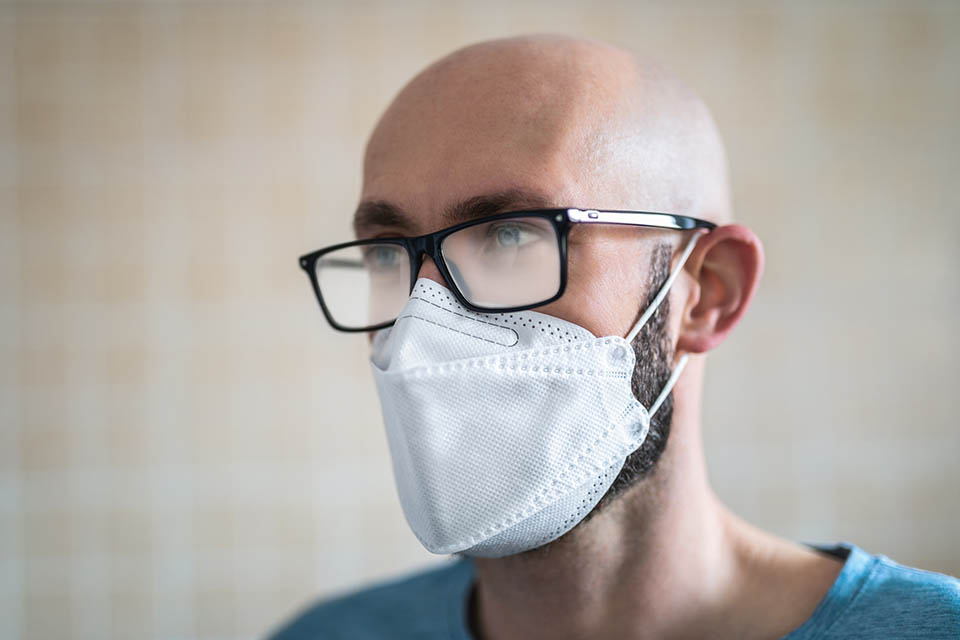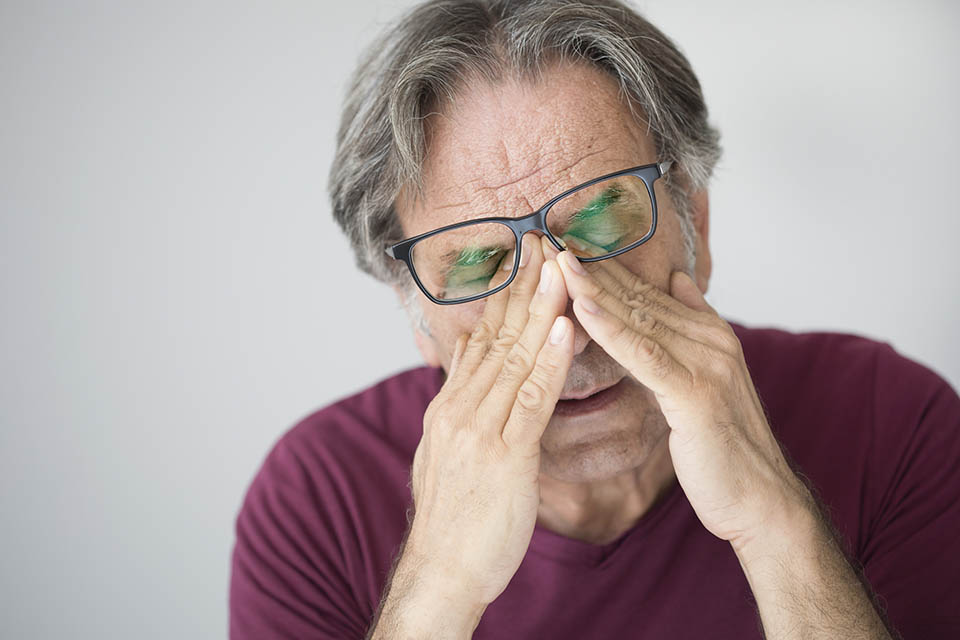- OT
- Industry
- Contact lenses
- Mask wearing: can contact lenses enhance patient lifestyle and safety?
The discussion
Mask wearing: can contact lenses enhance patient lifestyle and safety?
Can contact lenses help those who are struggling to wear face masks alongside spectacles? A spectacle wearer, an optometrist and a Bausch + Lomb expert offer some answers.

24 November 2020
Masks are essential. We all know this, and we also know that we’re likely to be living with them for quite some time.
However essential they are to fight the spread of COVID-19, though, there’s no escaping that, for spectacle wearers, there are challenges that come with mask use. Glasses steaming up, a loss of peripheral vision, general inconveniences whilst trying to juggle them with glasses outside shops… So, what solutions are there to the issue?
In partnership with Bausch + Lomb, OT spoke to optometrist, Sandip Doshi, Bausch + Lomb’s senior professional affairs associate UK&I, Serena Dunwoody, and spectacle wearer, Claire Stevens, about how contact lenses can provide an answer.
Steaming up and discomfort
Sandip Doshi says the most common issue he’s seen in recent months is that of glasses steaming up whilst patients are wearing masks. There are ways to minimise this, Sandip says, but as masks are compulsory it's difficult to eliminate the issue completely. The issue was exacerbated in the autumn, he says, with the cold having a significant impact. Sandip told OT that “pretty much every patient that I see will come in complaining of their spectacles steaming up.”

He explained that this can lead to patients adjusting the position of their glasses to try and mitigate the issue.
“Often, particularly with higher prescriptions, varifocals, or high astigmatism, patients end up wearing their glasses in the wrong position, and that affects their sight as well,” he said. “They're looking through the wrong bit of their lens, or their lenses are rotated in the direction that wouldn’t be conducive to the best vision. It poses a practical problem from the patient's perspective: everything is foggy.”
He added: “From our perspective, it poses the issue that they're not wearing the right prescription or are wearing their prescription spectacle lenses in the wrong position and therefore almost invalidating the use of them. That's becoming an increasing problem.”
Having glasses in the correct position is especially important with complicated prescriptions, Sandip says, and “when that isn't the case it really can be a problem.”
He adds: “When identifying those issues, obviously the first port of call is to try to correct it. However, because masks are mandatory, in most cases, no matter what we do, it is not going to solve the problem.”
Spectacle discomfort whilst wearing a mask is something that patients are reporting directly. Claire Stevens, a Bausch + Lomb team assistant from Kingston, has experienced this. Prescribed prescription spectacles 18 months ago, she now uses them whilst reading and shopping and is finding them increasingly intrusive. Her problems with spectacles have been exacerbated recently.

“I’m very aware of them,” Claire says. “Since face masks became mandatory for use within shops, I’m experiencing other issues as I have to pull the mask up onto my nose so my spectacles can sit over the top – this not only makes me feel very warm but it means that my spectacles can fog or steam up.”
She adds: “Another issue is my journey within the shop. I would often remove my spectacles while I browsed or walked around different aisles as my distance vision doesn’t need any support. However, I have the added inconvenience of my mask moving around and I am adjusting it and touching my face more.
“This experience makes me feel very vulnerable and unstable with my movement and peripheral vision. There is also a sense of claustrophobia. The sensation of spectacles was very prominent, but now there is the added sensation of the mask around the lower part of my face."
There’s a clinical consequence of mask wearing, too. Serena Dunwoody tells OT that she has seen an increasing number of reports related to the ocular surface, showing exacerbated symptoms both from pre-existing dry eye patients and patients that have never suffered from dry eye before.
“Reports suggest that these symptoms are worse for people who have to wear masks continually for long periods of time,” Serena said. “This is due to the upward flow of warm air coming up from behind the mask. This warm air can also affect the tear film as well. It causes higher rates of evaporation, which can lead to dry, gritty, irritated and watery symptoms for patients.”4
She added: “For the non-spectacle wearers or those patients that don't require any vision correction, there's the vision impact that results from the tear film instability. One of the things that can happen is excessive watering.”
Sandip agrees that all this can severely impact a person’s day-to-day. He said: “I see a fair few elderly patients, and there's a safety aspect for them: if their glasses are steaming up, getting across the road when they may not be so mobile, or walking on relatively uneven pavements when they might be unstable on their feet. It is quite a significant factor.”
He added: “This is where contact lenses are the ideal situation. We tend to find that recommending contact lenses to these patients, or, if they're already a contact lens wearer, asking them to increase their contact lens wear to get around these issues, has been quite positive.”
A proactive solution
So, how can contact lenses help in this situation? Sandip believes that, if wearing a mask outdoors becomes the law, the issue of glasses steaming up or being worn incorrectly is going to have much more of an impact – and that contact lenses can provide a helpful solution. It’s something that he has increasingly been advising his patients on in recent months. He’s found that they’re generally receptive to the idea. These patients may never have explored the idea of contact lenses before, so this can be a really good opportunity to offer this alternative vision correction option We are getting phone calls from people that are not current patients, asking to book in for contact lens fittings
He said: “We have a number of people who like the idea of the freedom away from spectacles generally, and now feel that there's a practical issue as well. We've got a number of bookings going forward with new fits.
“I've got a young lady who's a professional mixed martial artist. She feels that since I've fitted her with contact lenses, it's actually changed her game. She's competed at international level, and so far, touch wood, she's winning all of her matches.”
And what about patients who might be wary of contact lenses, perhaps after a lifetime of spectacles?
Sandip doesn’t think age needs to be an issue when it comes to contact lens wear. He told OT: “I fit very young kids; I fit very elderly patients. Age is really not an issue as far as contact lens selectivity is concerned. In a lot of instances, it can make a considerable improvement in patients' safety and mobility.”
Serena agrees that there have always been advantages to contact lenses, including a wider field of view, better depth perception, and on-eye vision stability.

She also believes that contact lenses can provide a good alternative for older spectacle wearers, because of the safety issues at hand: “These patients may never have explored the idea of contact lenses before, so this can be a really good opportunity to offer this alternative vision correction option,” she said.
There’s a wider health angle at the moment, too. Serena told OT that “contact lens wearers are less likely to touch or rub their eyes, as opposed to a spectacle wearer who may push their glasses up by habit or adjust them if they slip down the nose. This increases the chances of contaminating the spectacle surfaces, which can hold on to the virus for some time.”
She added: “Good contact lens compliance involves good hand hygiene, which we all know is really important right now. They can be beneficial from that point of view.”
Sandip strongly believes that “we, as a profession, can be much more proactive in suggesting contact lenses to people who traditionally might have thought that lenses weren't for them. There’s no reason why we shouldn't be considering contact lenses for most, if not all, of our patients.”
There are benefits for the practitioner, too: Sandip has seen an increased number of enquiries from those looking for an alternative option to spectacles. He told OT: “The word certainly seems to be getting out. We are getting phone calls from people that are not our current patients, asking to book in for contact lens fittings.
“It's important to be proactive in that respect. People do talk to each other.”
Lessening patients’ worries
For those who are concerned about making the switch to contact lenses, Serena has advice for optometrists who need to offer solutions to dry eye, caused by tears evaporating more quickly: lubricating drops or warm compress treatments. ECPs can also suggest that patients limit their time in air-conditioned environments, and limit screen time by taking regular breaks. All of these things, she told OT, “can really help the ocular surface.” We, as a profession, can be much more proactive in suggesting contact lenses to people who traditionally might have thought that lenses weren't for them I tell patients: if you were to get a drop of water in your eye, that's probably going to be more uncomfortable than a modern contact lens
Serena added that since ECPs are patient-facing, they can help to educate patients on the importance of wearing a face mask properly: “They'll be able to see first-hand if the mask is too loose or poorly fitting,” she said, “which is the main issue for fogging and making the eyes feel drier than normal. The general advice is to ensure the mask fits well by pinching it in around the nose and ensuring there's no gap around the upper cheek area, and then applying the spectacles over the mask so they're not in direct contact with the face.”5
From a patient perspective, Claire is open to suggestions that will make her day-to-day more straightforward. She told OT: “It's this whole issue of trying to put the face mask on, and then the spectacles on top. You've got to loop the face mask around your ears. The spectacles sit behind your ears, so if you've got long hair it's inconvenient.
“When the weather is not nice and you're moving from outside into the store, the glasses start to steam up. It's just not a nice experience. We know we have to wear the face mask, so I'm totally prepared to do that. But anything that would help make my face a little bit freer, I would be prepared to consider.”
Sandip believes that reassurance from the ECP is key for patient confidence. He said: “The first thing is to reassure people that contact lenses can be a real benefit for vision correction, and obviously if they use them appropriately, they can be really comfortable. I tell patients: if you were to get a drop of water in your eye, that's probably going to be more uncomfortable than a modern contact lens. Therefore, the comfort factor is not an issue.”
He explained: “On the handling of a contact lens, we mitigate that by saying, if you're taught properly how to do it, then we find that there are very few people that can't actually do it safely and effectively. It's the education that they're not going to be left in the lurch, trying to do it themselves. We will spend time with them, over several appointments if needed. We will make sure they can do it adequately and safely.”
Staying informed
With 20 years’ experience as a practice owner, Sandip is comfortable with addressing the majority of questions posed by patients. There are always lessons to learn, though, no matter how long you’ve been in the job, he acknowledges.
“What’s really important,” Sandip emphasised, “is being kept informed of latest technologies, particularly when a larger range of patients can be fitted with new products.
“I think it’s essential that we work together as a team with the suppliers, and they keep us informed with what's available. They’ve got amazing resources that, as an individual practice, I cannot produce myself.”
The use of social media has assisted his communications with patients in recent years, he told OT, with increased confidence coming when they recognise the products that he recommends to them: “If I can point people to various websites or to apps or to adverts, for example on Facebook or Instagram, that familiarity really does help. If a patient has seen an ad on Twitter, and I'm talking about that particular product for them, it does instil a large degree of confidence. They feel like I'm up to date, that I'm fitting the latest products, and that it's a product that they’re comfortable with because they've seen the brand and the name. I think that's important.”
He also emphasised the importance of being aware of what the manufacturers are doing, in terms of promoting contact lens wear and specifically their own products, because “the last thing we want is for a patient to turn up and say, "I've seen this advert about this lens. Do you know anything about it?" Hopefully, one would never shrug and say, “I don't.” You don't want to be left behind that curve.” If the patient only wants to wear lenses once or twice a week they can do. If they want to wear them instead of their glasses all the time when wearing a mask, they can do. There are a lot of options
Serena believes that the industry has reacted quickly on the subject of safety with contact lenses, and that ECPs should feel confident offering lenses to new wearers who would benefit from them.
She said: “As long as the patient understands and adheres to being compliant, it should be easy to explain. They can persuade the patient to switch to contact lenses by discussing the benefits that contact lenses can bring to their current lifestyle needs, knowing that they can benefit from great vision.
“There are lots of designs available, and there are lots of material types and modalities to suit their lifestyle. If the patient only wants to wear contact lenses once or twice a week they can do that. If they want to wear them instead of their glasses all the time when wearing a mask, they can do that, too. There are a lot of options.”
She also emphasised the benefits that lenses can have in terms of communication: “The eyes and the mouth are the most expressive regions of our facial features,” she pointed out. “Now, when we're having to wear masks as a rule, patients could respond really well to the idea of contact lenses over glasses, because the eyes are a means of communication now, more than ever before.”
She added: “There are spectacle wearers out there that would never have thought of contact lenses before, because they've always been happy with their specs. They're now really knowing the limitations that this situation has brought upon them. Hopefully ECPs can help relay that.”
How Bausch + Lomb can help

Bausch + Lomb’s Serena Dunwoody tells us how the company is providing solutions for both ECPs and patients
How can Bausch + Lomb’s products provide a solution to the issues that patients are facing?
Bausch + Lomb has always been committed to innovation and making sure our patients’ needs are fully understood and met. Creating new innovative contact lens materials and lens care solutions has been a large part of that. With Biotrue® ONEday daily disposable, the material was made by understanding the complexity of the tear film and what leads people to wear contact lenses less or not at all, which led us to create this material with 78% water1 and the ability to maintain almost 100% of that moisture for a full 16 hours.2 Biotrue® ONEday allows wearers to enjoy comfortable vision from first thing in the morning to last thing at night.3 This has enabled us to keep our commitment to allow our patients to see better to live better.
What suggestions can you offer ECPs in persuading patients to try contact lenses for the first time, or in upping their wear if they use them already?
ECPs can persuade patients to switch to contact lenses by simply discussing the benefits contact lenses can bring to their current lifestyle needs, knowing that they will benefit from having great vision and comfort with all the designs, material options and modalities that are available to suit their lifestyle needs. This is something that the whole practice team can be involved in, as we know they are ‘front of house’ and often the first person a patient talks to.
It is imperative that all practice team members are proactively discussing contact lenses throughout the patient journey, engaging in conversations around the patient’s lifestyle needs and how their current vision correction is working for them when carrying out day to day tasks. By doing this the practice can identify candidates suitable for contact lenses as well as spotting any potential dropouts, who can easily be upgraded into newer technologies in contact lens options.
Additionally, practices can also convey to patients that they actively fit contact lenses with in-store advertising and by promoting contact lenses on their social media platforms.
Find out more at: https://bausch.co.uk/mostmoisture/
- ACLM, 2020. ACLM Year Book Online
- Bausch + Lomb, 2012. A clinical evaluation of Biotrue® ONEday compared to 1-DAY ACUVUE® MOIST,® 1-DAY ACUVUE® TruEye® and DAILIES® AquaComfort PLUS® dehydration data preliminary results and claims support (ROC2-11-63). Rochester
- Bausch + Lomb, 2012. A study to evaluate the product performance of a daily disposable soft contact lens (#700). Rochester
- Jones, L., 2020. Why face masks can make eyes feel dry, and what you can do about it. [online] [Accessed 11 November 2020]
- BCLA in association with Euromcontact, 2020. Tips on seeing clearly while wearing a mask.
Biotrue is a trademark of Bausch & Lomb Incorporated or its affiliates. All other brand names are trademarks of their respective owners. ©2020 Bausch & Lomb Incorporated. BOD.0035.IE.20
More The discussion



Comments (0)
You must be logged in to join the discussion. Log in